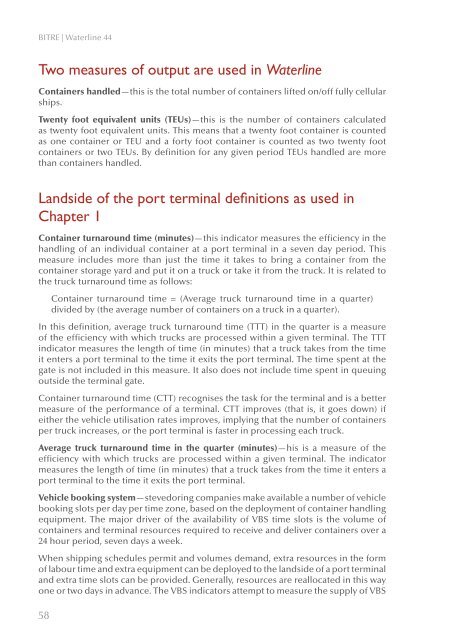PDF: 1352 KB - Bureau of Infrastructure, Transport and Regional ...
PDF: 1352 KB - Bureau of Infrastructure, Transport and Regional ...
PDF: 1352 KB - Bureau of Infrastructure, Transport and Regional ...
- No tags were found...
You also want an ePaper? Increase the reach of your titles
YUMPU automatically turns print PDFs into web optimized ePapers that Google loves.
BITRE | Waterline 44Two measures <strong>of</strong> output are used in WaterlineContainers h<strong>and</strong>led—this is the total number <strong>of</strong> containers lifted on/<strong>of</strong>f fully cellularships.Twenty foot equivalent units (TEUs)—this is the number <strong>of</strong> containers calculatedas twenty foot equivalent units. This means that a twenty foot container is countedas one container or teu <strong>and</strong> a forty foot container is counted as two twenty footcontainers or two TEUs. By definition for any given period TEUs h<strong>and</strong>led are morethan containers h<strong>and</strong>led.L<strong>and</strong>side <strong>of</strong> the port terminal definitions as used inChapter 1Container turnaround time (minutes)—this indicator measures the efficiency in theh<strong>and</strong>ling <strong>of</strong> an individual container at a port terminal in a seven day period. Thismeasure includes more than just the time it takes to bring a container from thecontainer storage yard <strong>and</strong> put it on a truck or take it from the truck. It is related tothe truck turnaround time as follows:58Container turnaround time = (Average truck turnaround time in a quarter)divided by (the average number <strong>of</strong> containers on a truck in a quarter).In this definition, average truck turnaround time (TTT) in the quarter is a measure<strong>of</strong> the efficiency with which trucks are processed within a given terminal. The TTTindicator measures the length <strong>of</strong> time (in minutes) that a truck takes from the timeit enters a port terminal to the time it exits the port terminal. The time spent at thegate is not included in this measure. It also does not include time spent in queuingoutside the terminal gate.Container turnaround time (CTT) recognises the task for the terminal <strong>and</strong> is a bettermeasure <strong>of</strong> the performance <strong>of</strong> a terminal. CTT improves (that is, it goes down) ifeither the vehicle utilisation rates improves, implying that the number <strong>of</strong> containersper truck increases, or the port terminal is faster in processing each truck.Average truck turnaround time in the quarter (minutes)—his is a measure <strong>of</strong> theefficiency with which trucks are processed within a given terminal. The indicatormeasures the length <strong>of</strong> time (in minutes) that a truck takes from the time it enters aport terminal to the time it exits the port terminal.Vehicle booking system—stevedoring companies make available a number <strong>of</strong> vehiclebooking slots per day per time zone, based on the deployment <strong>of</strong> container h<strong>and</strong>lingequipment. The major driver <strong>of</strong> the availability <strong>of</strong> VBS time slots is the volume <strong>of</strong>containers <strong>and</strong> terminal resources required to receive <strong>and</strong> deliver containers over a24 hour period, seven days a week.When shipping schedules permit <strong>and</strong> volumes dem<strong>and</strong>, extra resources in the form<strong>of</strong> labour time <strong>and</strong> extra equipment can be deployed to the l<strong>and</strong>side <strong>of</strong> a port terminal<strong>and</strong> extra time slots can be provided. Generally, resources are reallocated in this wayone or two days in advance. The VBS indicators attempt to measure the supply <strong>of</strong> VBS
















